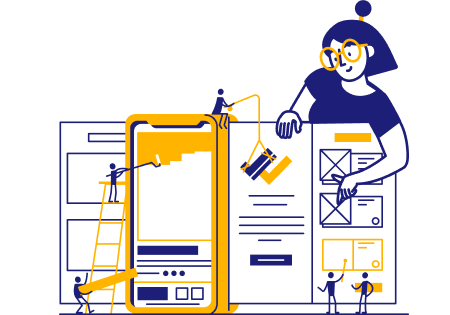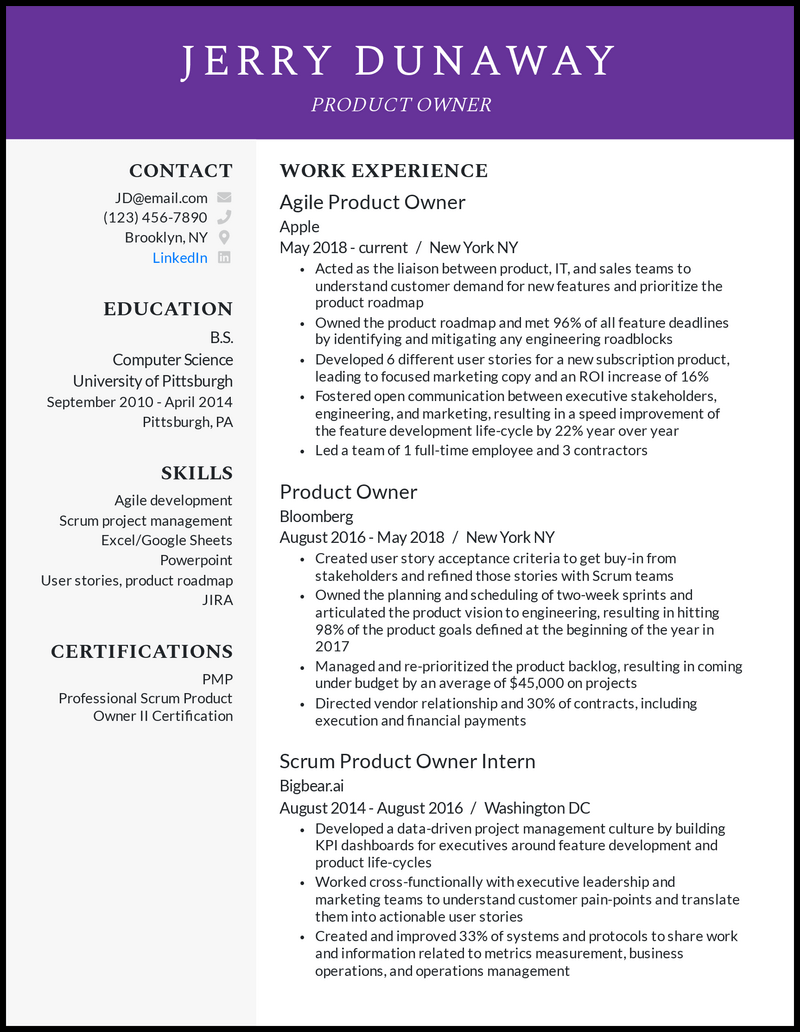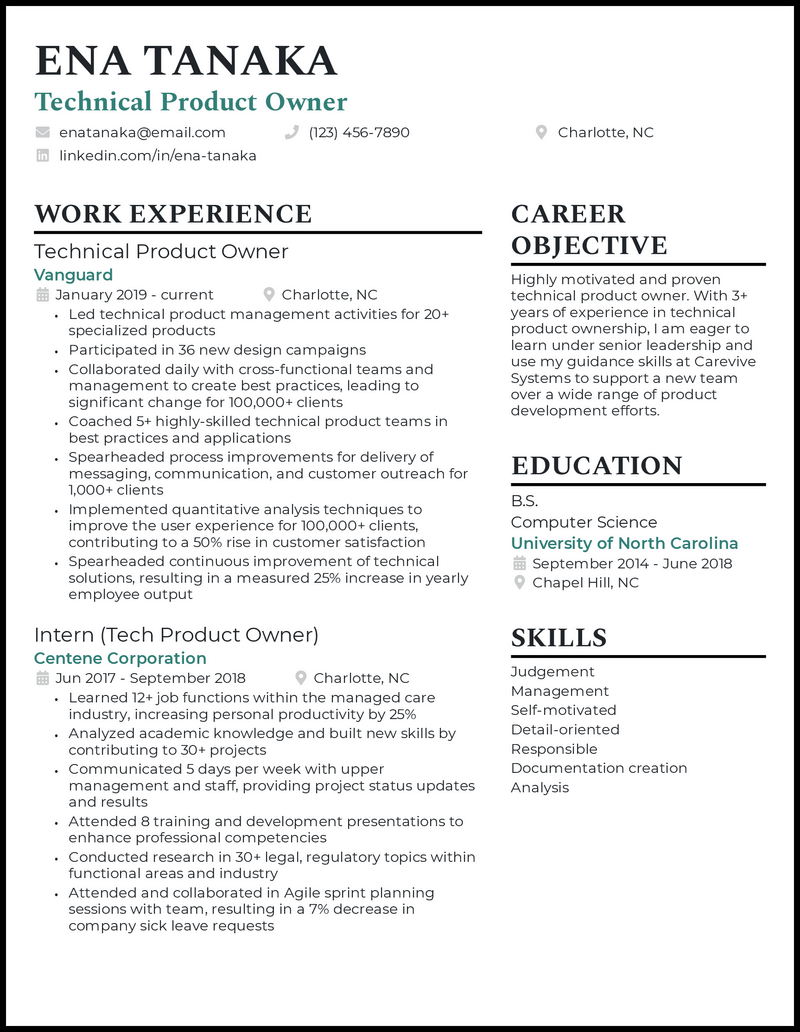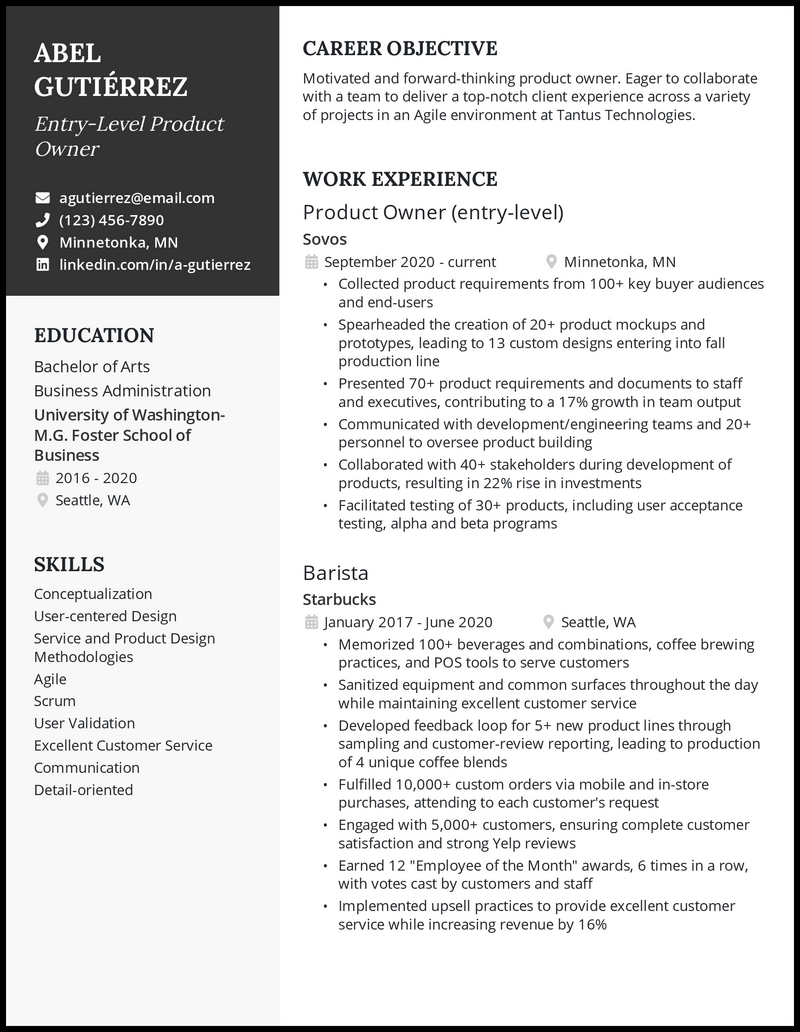
Product Owner





Best for candidates with 3+ years of experience
Resume Builder
Like this template? Customize this resume and make it your own with the help of our Al-powered suggestions, accent colors, and modern fonts.
You’re a great product owner—you shouldn’t also have to be great at writing a resume or creating a cover letter!
You have one goal with your resume: to make it clear to the hiring manager that you’re a great fit for the product owner role to which you’re applying.
We’ve worked with product leaders to learn what they’re looking for, and what they’re not, in an applicant for a product owner role. These 11 product owner resume examples for 2026 have helped people land jobs at great companies like Microsoft and Apple.
We’ll also give you an inside scoop on the expert resume tips we’ve learned from professionals with whom we’ve spoken.
Why this resume works
- A role as diverse as a product owner requires an equally diverse resume. Regardless of your proficiency level, there are essential foundations that can be determined by evaluating position requirements in the product owner job market, no matter the location.
- Starting with a foundation of a B.S. in computer science, followed by a summer internship, can successfully land you a majority of junior to mid-level roles.
- Customize current and previous job titles, tailoring them to fit the position and job description when you’re seeking a specific role. Commonly interchangeable job titles such as Agile product owner and Scrum product owner have virtually identical responsibilities. However, they’ll be better received by your product owner resume reader due to the title of the job to which they’re applied.
- If you’re uneasy about altering previous/current position titles, reach out to your manager, HR, or whomever you listed as a work reference. Always err on the side of caution. Asking for permission instead of forgiveness is universally better.
Why this resume works
- Your technical product owner resume should be easy to read while also conveying necessary information about qualifications and experience.
- Streamline it with the right resume template and resume format because a computer will review it first; fancy images or graphics are hard for software to parse.
- The resume objective gives a helpful glance at what the rest of the resume highlights. It should touch on your qualifications and explicitly state what you’re looking for in your next role.
- When you document your past work experience, chronicle it in reverse-chronological order; that is, begin with your most recent experience, and work in reverse.
- This order will help you present the most recent and, therefore, most senior experience, first and foremost.
View more technical product owner resumes >
Why this resume works
- As you gain more professional experience, senior product owner job seekers can display their top career highlights. By choosing specific KPIs (Key Performance Indicators), your resume reader will associate your career highlights with your current abilities.
- Instead of a career objective or comprehensive summary, your resume should focus the reader’s attention on relevant experience, the mark of a true senior.
- When updating your resume skills list, there are two primary sources of data you must collect. The first is the position’s list of required skills if you are singling out a particular company. This list will give you the exact skills needed to excel in the role to which you’re applying. The second source takes a general look at desired job titles in a specific geographic location. After evaluating the market’s desired skill requisites, you can adjust your expertise to the general “heartbeat” of what jobs in a given area are seeking.
- Your senior product owner resume should be built on the former to guarantee success.
View more senior product owner resumes >
Why this resume works
- Products are valuable as long as their market demand stays at its peak. You’re doing yourself a big favor by ensuring the product-to-market time is fast to sustain demand while keeping clients satisfied.
- To make that count in your Agile product owner resume, emphasize how you creatively streamlined processes to shorten the product development process and ensure timely launches.
Why this resume works
- Jessica, the hiring manager, is sipping her cappuccino and throwing 90% of the applications she’s opening in the trash. How about ensuring yours is in the safe 10% by tailoring your development product owner resume to the open position?
- Read the job description multiple times and take note of the required qualifications and keywords. Done that? Good. Now, sprinkle those phrases in your piece and ensure that your skills and experiences align with the role.
Why this resume works
- Easy-to-use resume templates can enable you to add sections specifically for skills, education, and even special certifications. The first thing administrators check for in people applying for entry-level positions is whether they have the fundamentals to perform the job adequately.
- If you’ve got certifiable skills but lack certification, your professional achievements can showcase the practical application of transferable skills.
- Focus your entry-level product owner resume on specific contributions you made at previous companies.
- For example, instead of writing something nonspecific like “communicated with coworkers,” list concrete details like “collaborated with 40+ stakeholders during product development.”
- Or “engaged with 5,000+ customers, ensuring complete customer satisfaction.”
View more entry-level product owner resumes >
Why this resume works
- Whenever possible, it’s important to quantify the effect you’ve had in your past roles as a digital product owner. For example, how many hours did you save by reshaping the onboarding process? How many customers loved the product so much that they felt obligated to leave an overwhelmingly positive review?
- Example: Shaped and implemented overall strategy, execution, and management of digital onboarding, which saved an average of 3 hours per onboarding
- Example: Drove continual evolution and enhancement of digital customer experience, which increased 4 to 5-star reviews by 300%
- In addition to highlighting a comprehensive list of skills on your digital product owner resume, be sure to emphasize their applicability by working them into quantitative examples.
- Example Resume Skill: Teamwork—partnered with the analytics team to develop reporting methodologies and visualizations.
View more digital product owner resumes >
Why this resume works
- A data product owner resume without quantified outcomes is as dead as a doornail and will hardly cut it when it comes to convincing the recruiter you can be an asset to the team.
- But what’s so captivating about adding metrics to your sales pitch? A lot—More importantly, they show you weren’t just there for the ride at your former places of work; you left a mark. Plus, they make it easy for recruiters to stack you against the competition.
Why this resume works
- Product relevance is built by sustaining a frequent presence in the market. Can you ensure a seamless flow of products to the market and stay in the minds of clients?
- Yes, and you can leverage it to boost the chances of your Scrum product owner resume getting the job by emphasizing your initiative to advocate for smaller and more frequent releases.
Why this resume works
- As an associate product owner, you might not have multiple years of industry experience to showcase your abilities. This can easily be overcome by directing the reader’s attention to two main areas: career objective and work experience.
- Career objectives exist to support and enhance whatever work experience is listed. Instead of opting for a lengthier resume that includes irrelevant experience, your associate product owner resume should use a career objective to instill confidence in the reader that you have a proven, albeit short, history of driving value.
- As you progress through your career, resume bullet points will easily pack more punch and should be filled with impressive metrics of your achievements and overall impact on previous companies.
- If your total amount of direct career experience is light, do your best to use simple metrics and percentages to show you made a measurable difference in your workplace.
Why this resume works
- When building a resume and career, the absorption of skills and experience is as inevitable as necessary. Yet, including too many, too few, or unrelated skills can easily trip the resume reviewer’s defense system.
- Design your software product owner resume with a singular target role in mind. By selling the target company what you know they want (the job description has all the answers), you can ensure success, even if cumulative years of experience fall below the “ideal candidate” minimum.
- Since you want to make the experience of the person reviewing your resume as pleasant as possible, the format matters. Choose one that highlights your strengths in the order best suited to the position. In this case, contact information, education, and skills are the first thing your reader will see.
- This order gives a strong viewpoint to see lengthy professional history, combined with excellent quantitative highlights.
Related resume guides
How to Write a Product Owner Resume

As the liaison between executives, the product team, and engineering, product owners have a lot of responsibility within an Agile organization.
How can you fit the full scope of the projects you’ve worked on in a single-page resume? It’s not easy, but these tips will help you put your best foot forward to the hiring manager.
Here are three things you need to do to create a resume that succeeds:
- Demonstrate your skills so that you get past automated ATS filters but also appeal to the product leader who will review your resume.
- Format your resume properly. This means keeping it to one page and avoiding any images. Include a skills, education, and work experience section.
- When talking about your past projects, quantify the impact of your work. The quickest way to demonstrate you’re a great candidate for a product owner role is by showing off the impact of your past work.

Demonstrate your product owner skills
When you apply for a product owner role, there are three different phases your resume review will undergo at the company to which you’re applying:
- Companies use an automated Applicant Tracking System (ATS) to only pass through candidates who meet certain keyword filters.
- The HR (non-product) person will review your resume. They’ve worked directly with the hiring manager to understand what qualifies someone for the product owner role.
- The product leader/ hiring manager will review your candidacy. They’re experienced in product.
How can you write a resume to get past all three phases of the resume review process?
First, you need to include the right keywords to get past the ATS filters. Your resume needs to include the keywords that are must-haves for the role. For example, if the job description makes it very clear that they’re requiring candidates to have experience with Jira then you can be sure the ATS will be filtering for that keyword.
What skills should a product owner have on a resume?
- Agile development
- Scrum project management
- Microsoft Excel, PowerPoint, Word, Outlook
- Google Sheets, Docs, Slides
- User stories
- Product roadmap
- Product backlog
- Jira, Basecamp, Asana
You don’t need to include all of these skills on your resume. This will just give you an idea of the common resume skills that companies are looking for product owners to have.
Now that you’re past the ATS it’s time for the HR person to review your resume. The key here is to only include skills in which you have a high level of proficiency.
The rule of thumb is only to include skills on your resume on which you’d be comfortable being interviewed. Lying on your resume is a surefire way to guarantee you’ll get added to a company’s blacklist for potential employment in the future.
All of the skills on your resume should be hard skills. Think about it. If you’re the hiring manager, what value does seeing “communication” on an applicant’s resume provide? None. You need to demonstrate soft skills in context, not just list them.
Including soft skills in your skills section won’t help you get past either the ATS filter or any stage of human review of your resume.

Make sure your resume format is correct
There aren’t any tricks to properly formatting your resume properly. The keys are:
- Keep it to one page. This is important.
- Don’t include graphics or images. It needs to be machine-readable.
- Please, please, please don’t have spelling or grammatical errors. This will make your resume an easy “no” for the hiring manager.
- Unless you’re undergoing a career change or have a specific interest in the company you’re applying to, exclude a resume objective or summary.
- If you’re an entry-level product owner, include relevant classes on your resume.
- Break up your resume into easy-to-consume, small bullet points.
You have one singular goal with your resume: make the job of the hiring manager as easy as possible.
You need to make it crystal clear that you’re a great fit for the product owner role to which you’re applying. All of these formatting tips are in service of this mission.
Why keep it to one page? Because if your resume spans multiple pages, the hiring manager will skim it. If you include any superfluous information in a bullet point, you run the chance of that being the resume reviewer’s focus.
Your resume should be a true highlight reel. This means keeping your resume to one page.
For a given product owner role, a company will have over 60 applicants. The HR person reviewing your resume is also leading the hiring for 5-10 other roles. This means they’re looking for a reason to say “no” to your candidacy.
Making a grammatical or spelling error is the quickest way to ensure you get rejected. Use Grammarly and have two to three other people read your resume before you start submitting it for job applications.

Resume objective or summary
A resume objective helps you demonstrate why you’re passionate about a particular role or problem that a company is solving.
A resume summary is a quick overview of a product owner’s experience or qualifications for a given role.
As a rule of thumb, you almost certainly don’t need to include a resume summary. Why? They rarely demonstrate anything that can’t be learned from reading the resume.
Similarly, there are only two cases in which you should include a resume objective:
- You’re undergoing a career change
- You actually have a specific interest in the role or company to which you’re applying
Since you should keep your resume to one page, you can’t afford to waste space. If you include a resume objective, it should be tailored to each job to which you’re applying.
WRONG – generic resume objective
Experienced product owner seeking to leverage my organization and communication skill sets to create products that have a meaningful impact on the company.
RIGHT – product owner resume objective demonstrating passion
Product owner seeking to leverage my experience in Agile development in education to contribute to the Coursera mission of making learning accessible for everyone in the world.
RIGHT – product owner resume objective for a career change
Product owner transitioning from a career in engineering looking to leverage my technical background to create products with TuSimple, Inc. that make it easier for non-coders to build businesses.
The differences in these resume objectives are clear. The first does not give the hiring manager any real information about why you’re a great fit for the product owner role. It just takes up space on the page.

Highlight education
What should be included in the education section of your product owner resume will vary based on your experience level.
If you’re more junior, you want to include more information in the education section to make your case that you’re a strong fit for the product owner role. Conversely, if you’re more senior, you want to have your education section take up as little space as possible in favor of your work experience.
Regardless of how much experience you have, you should always include the school you attended, the degree you earned, your major, and your minor if you had one.
Here’s what you should include depending on your seniority:
Education: entry-level product owner
- Include relevant statistics, design, business, or engineering classes you took in school
- Include your GPA if it was greater than 3.2
Education: senior product owner
- Don’t include college classes on your resume. Since you want to keep your resume to one page, you can’t afford to give up that space!
- No need to include your GPA
- Include a section if you have any relevant certifications (Scrum or Agile certifications, for example)

Quantify your impact
As a product owner, you know better than anyone how important it is to set tangible goals for products and features.
What better way to demonstrate your competence than to highlight some of those goals in your resume? By talking about your work projects quantitatively, you quickly highlight your understanding of how important goal setting is for an Agile product owner.
When talking about the impact of your work, you can give rough estimates. These impacts can be around metrics like revenue, customer adoption, growth, customer satisfaction, and more.
How to quantify your work as a product owner
- Revenue lift
- “Created user stories that were incorporated in both the product and marketing copy, resulting in revenue lift of $325,000 annually”
- Time savings
- “Took ownership of the product roadmap and improved the speed of the feature development life-cycle by 22%”
- On-time delivery of features
- “Hit 96% of the deadlines set for product features in 2019”
- Delivery on roadmap
- “In 2019, incorporated 92% of all of the product goals that were planned at the beginning of the year”
- Cost savings
- “Managed the product backlog and efficiently re-prioritized the backlog, resulting in coming under budget by $45,000 on average for projects”
- User engagement
- “Worked closely with product and engineering teams to ship features that improved user engagement by 32% year over year”
Measuring impact is vital for any successful product owner and hiring manager who wants to see that you have this ability. More than that, quantifying the impact of your work is much more convincing than general statements.

Work experience for entry-level product owners
It’s much easier to talk about your work experience when you actually have some work experience! What do you do if you’re an entry-level product owner looking for your first job?
You need to demonstrate the skills that hiring managers are looking for in other ways. You can do this through side projects you’ve worked on at school or on your own.
Did you do customer research for a potential app idea you have? Did you create user stories for a website you wanted to build? Did you start and grow a club at school? You should still aim to quantify the impact or scope of these projects.
For entry-level roles, companies want to hire people who have demonstrated an interest in product. So if you don’t have any projects you’ve worked on, now is a great time to make that happen.
Reach out to local small businesses you can help, volunteer to develop user stories for a local non-profit, do market research for a potential product and put together a PowerPoint, and do a competitive analysis for an existing product you like. A project can be anything that demonstrates you know what it means to own a product and have the skill set to do so.

The takeaways
You’re well on your way to creating the perfect Agile product owner resume and scoring your next job. Start with the resume templates we provided at the top of this post, and be sure to incorporate these three expert tips:
- Include relevant hard skills in the skills section of your resume. Avoid a laundry list of skills, as this will be a red flag to the hiring manager.
- Keep your resume to one page. Triple-check for spelling and grammatical errors. Send it to a friend and have them check for spelling and grammar as well.
- Quantify the impact of your work experience and projects. If you’re entry-level, try to take on projects that demonstrate you can successfully be a product owner.
I know that applying for new jobs is just as fun as going to the dentist or moving, but you took a huge first step! Now go forth and apply wisely. Before you know it, you’ll be a product owner at a great company.
Product Owner Resume FAQs

To write a compelling product owner resume, align your experience with the key requirements recruiters seek. These may include product lifecycle management, business value delivery, stakeholder collaboration, and agile methodologies. Read the job description and use keywords, skills, and industry-specific jargon to elevate your chances of getting noticed.
A product owner resume summary is a concise, high-impact section at the top of your resume that discusses your professional identity, top achievements, and the value you bring. It sets the tone and tells potential employers why you’re the right fit—fast.
Example: Certified Scrum Product Owner (CSPO) with 10+ years leading cross-functional teams to deliver impactful digital products in Agile environments. Led a SaaS launch that boosted retention by 28% and cut churn by 19% in 6 months. Expert in aligning business needs with technical solutions, managing stakeholders, and executing product roadmaps. Committed to building user-focused, scalable innovations.
Absolutely—if you’ve been a product owner, it should be prominently featured on your resume. This title should reflect your strategic product development role and align with the advertised position in tech, SaaS, or enterprise sectors.
Your product owner resume should detail how you take leadership initiatives and manage cross-functional teams to meet all sprint goals on time and release high-impact product features. Include quantified metrics to show how you’ve aligned business objectives with user feedback in previous roles.
The reverse chronological resume format works best for a product manager resume. With your latest work experiences at the top, employers can instantly view your most recent accomplishments and the value you can bring to their team.



















